Items
Site
The Medicine Chest
Is Part Of is exactly
Pathology
-
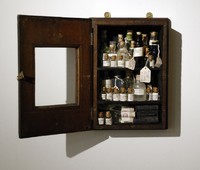
First Aid: Homage to Joseph Beuys
This work by the artist, Susan Hiller, consists of 13 vintage felt-lined wooden first aid boxes, 86 vintage bottles, water from holy wells and sacred streams, and vintage medical supplies. -
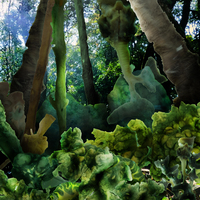
A 'Jungle'
"A ‘jungle’ consisted of a selection of pathological specimens from the Pathology Learning Centre that had been affected by typhoid fever, ascaris adult worms, yellow fever, amoebic ulcerations, tuberculosis and malaria. The diseases that afflicted these specimens were regarded as ‘tropical’. As described in Chapter One, BWC used the jungle as a significant terrain that called for a medicine chest to combat pathogens: ‘Whether you were valiantly saving your compatriot in war, traversing a dark African jungle, navigating one of the world’s first flying machines, exploring the most desolate place on earth, ascending the highest mountain in the world, or simply enjoying the windswept British coast, the chest would be there, ready for any ailment’ (Johnson 2008b: 255). BWC promoted their chests as the ideal antidote for a tropical landscape ‘at once full of potential wealth for imperial Britain, but simultaneously rife with disease’ (Johnson 2008b: 258) and claimed that the tropical colonies were ‘by far the most dangerous regions for travellers’ (BWC 1934: 8). It was here that ‘desolating ailments’ were encountered, all ‘particularly fatal to the so-called white man who originates in temperate climates’ (BWC 1934: 8). I adapted the colour of the images of afflicted intestines, livers, stomachs and brains and used them as material to construct a dense jungle that referenced this aspect of the medicine chest’s history. Printed on separate glass sections that fit into the cabinet at spaced intervals to create an illusion of depth and three-dimensionality, the work draws on the cross-sectional display technique used in many anatomy museums worldwide, in projects such as the Visible Human Project (1995) and that the artist Damien Hirst references in his works . Creating a visual link between the UCT specimens and the history of these diseases surfaces the occluded racial undertones of these understandings" (Liebenberg 2021: 267). -
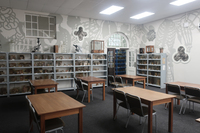
Subtle Thresholds (PLC)
"Integrated into the PLC, these works speak to the specimens on display and provide interesting access points to the collection. The animal-faeces prints (which referenced ‘sites of contamination’ in the context of the SAM exhibition) resonate, for instance, with many of the specimens on display in the PLC, such as the heterotopic heart (also called a ‘piggy-back heart transplant’) created by Dr Chris Barnard in 1977, consisting of a baboon heart grafted onto a human heart for additional motoric support. In addition to their more ‘famous’ specimens, the centre also has an extensive intestinal worm collection and many organs affected by zoonotic diseases, such as a liver ravaged by malaria. This was not a conscious decision on the part of the artist-curator and illustrates how curation can draw attention to aspects of a collection and liberate new associations when brought into conversation with it" (Liebenberg 2021: 201). -

Planthology (detail)
“For 'Planthology (Bulbine frutescens and Lessertia frutescens)' I sourced two medicinal plant specimens from Kirstenbosch National Botanical Garden and x-rayed them at Groote Schuur Hospital (#10 and #13). These two local plants offer a wide variety of healing properties and address the lacuna of the chest. The fresh leaves of the Bulbine frutescens produce a jelly-like juice that can be used for burns, rashes, blisters, insect bites, cracked lips, acne, cold sores, mouth ulcers and areas of cracked skin, while an infusion of these leaves in a cup of boiling water can be taken for coughs, colds and arthritis (Harris 2003: online). The Lessertia frutescens is used as an immune booster in the treatment of HIV/AIDS, as a medicine in the treatment of chicken pox, internal cancers, colds, asthma, TB, bronchitis, rheumatism, rheumatoid arthritis and osteoarthritis, liver problems, haemorrhoids, piles, bladder and uterus problems, diarrhoea, dysentery, stomach ailments, heartburn, peptic ulcers, backache, diabetes, varicose veins and inflammation (Xaba & Notten 2003: online)” (Liebenberg 2021: 269). -
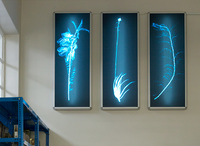
Planthology
In conversation with Dr Yeats in 2011 about adding a few medicinal plants to the centre as part of its displays, she mentioned that no plants survived in there. They all seemed to die from some mysterious cause. I decided to source three medicinal plants, the Lessertia frutescens, Bulbine frutescens and Artemisia afra, and X-ray them to 'diagnose' what might be the cause of their demise. In subjecting the plants to this process and placing the x-ray images in a space that foregrounds the diagnosis of human disease, I intended to create a heterarchical shift in this relationship, considering a world in which the degree of care directed toward human ailments might be replicated in treating diseases manifest in the botanical world. -

The Heterotopic Hearts
“On two occasions in 1977, when a patient’s left ventricle failed acutely after routine open-heart surgery and when no human donor organ was available, Barnard transplanted an animal heart heterotopically. On the first occasion, a baboon heart was transplanted, but this failed to support the circulation sufficiently, the patient dying some six hours after transplantation. In the second patient, a chimpanzee heart successfully maintained life until irreversible rejection occurred four days later, the recipient’s native heart having failed to recover during this period. Further attempts at xenotransplantation were abandoned and even now, more than 30 years later, xenotransplantation remains an elusive holy grail despite decades of research.” Extract: Brink JG, Hassoulas J. The first human heart transplant and further advances in cardiac transplantation at Groote Schuur Hospital and the University of Cape Town. Cardiovasc J Afr. 2009; 20(1):31-5 -

Post-mortem ledger
A wounded post-mortem ledger -

The Northern Lights
Histology slides of the brain (human and animal), scanned and converted into video projection -

Micrographia
Engraving, magnified view of the forms of small diamonds or shining sparks in flints (fig. 1), "the forms of gravel in urine (fig. 2), and a variety of regular for resulting from various combinations of globules (fig. 3, 4)"; Schem. 5. From 'Micrographia: or some physiological descriptions of minute bodies made by magnifying glasses with observations and Inquiries thereupon' by Robert Hooke, Fellow of the Royal Society, 1665. -

Geometry in unlikely places
"These bladder stones are most likely made up of calcium oxalate; they are faceted because they rub against each other. (Faceting only occurs when there are two or more stones together)". -

Haematite Miner's Lung (Or Sidero-silicosis)
Catalogue No: R3-d55-0331. Origin: UCT Anat Path museum. Old Museum No: V:x:6. Year: not recorded. Clinical data: No further clinical or laboratory details are available other than that the patient was an emaciated 50 year old man. Macroscopy: The specimens preserved are both lungs, the heart, kidneys, spleen and and portions of liver. In the thorax, both pleural cavities were completely obliterated by a fibrous pleurisy of long-standing and both lungs were universally adherent throughout. They were stripped off with difficulty and were found to have thickening of the pleura over the upper lobe on the left side and the upper and middle lobes on the right. The lower lobes on both sides were soft and spongy while the upper lobes were dense and firm on palpation but on section there was no cavitation and no evidence of tuberculosis. The left lung showed a dense fibrosis of the whole of the upper lobe and the upper third of the lower lobe; no crepitant lung tissue could be found in the upper lobe while the lower two-thirds of the lower was crepitant and showed emphysema of a hypertrophic nature. The lung was a dull brick colour and haematite dust flowed out with the fluid when the lung was sectioned. The right lung presented a similar appearance to the left. There was a solid dense fibrosis of the upper and middle lobes and the lower lobe showed fibrosis with hypertrophic emphysema. There was no evidence of tuberculosis and on palpation, a dense fibrosis was found with no nodular formation whatever. On section, it showed a similar appearance of a brick-dust colour, dilated bronchi and uniform fibrosis of the upper and middle lobes with no crepitant lung tissue. The pericardial sac was slightly increased in size due to a hypertrophied and dilated heart. The hypertrophy was mostly on the right side and there was a terminal dilatation of the right atrium; the valves and coronary vessels unremarkable.The liver was small and on section showed venous congestion and cloudy swelling. Microscopy: On microscopy, sections of lung show a diffuse fibrosis of both upper lobes with no recognizable lung tissue. The fibrosis in areas has a slightly whorled arrangement, the centre of which is hyaline and contains no iron pigment and surrounding it is a zone of cellular tissue containing masses of iron. In the upper part of the lower lobe where the lung tissue is recognizable as such, a few nodules definitely resembling silica nodules are to be seen. In the both lower lobes a solid oedema was noted and emphysema marked. The fibrosis was not present to anything like the same extent in the lower lobes, the emphysema being the most marked feature. No evidence of tuberculosis was found in either lung, though a calcareous gland was found in the hilum. Under polarised light, the iron showed up as a golden brown with a few points of light, clear, needle-like in contra-distinction to the iron lying free in the fibrous tissue. The macrophages are beautifully shown lying inside the alveoli filled with iron dust. Percentage of Ash 16.6 Percentage of silica to ash 6.6 Percentage of silica to dry lung 1.1 Percentage of iron to ash 10.3 Percentage of iron to dry lung 6.7 Comments: In summary, the post mortem findings were of: Dense pulmonary fibrosis; hypertrophied and dilated right ventricle; failure of compensation. This condition is described as haematite miner's lung or sidero-silicosis, caused by the inhalation of dust containing silica and ferric oxide which is the principal component of the ore. The fibrosis is thought to be caused primarily by the silica and the exact role of the iron pigment in the pathogenesis of the lesion is not clear. The earliest lesions occur as small densely fibrous, sub-pleural foci usually in the upper lobes; these grow by coalescence of adjacent foci until a diffuse fibrosis of the whole lobe is produced. Haematite miner's fibrosis is commonly associated with tuberculosis and other chronic lung infections; in addition there is quite a high incidence of carcinoma of the lung reported in these cases. -

Pompei casts
-

Silicosis
A gold miner using a rock drill with a water spray in an attempt to prevent the occupational disease silicosis, caused by dust inhalation. -

Observing marbling in Edirne
A marbling demonstration observed during a 2012 trip to Istanbul and a visit to the neighbouring Edirne's Health Museum. Opened in Sultan Bayezid II külliye in 1488, the hospital treated patients for over 400 years, until 1909, along the tradition of Turkish-Islamic medicine, which included the treatment of diseases by music. -

Lotus Leaves (Full Leaf)
"Gabriel Orozco's interest in the natural world and its relationship with humans inspired him to have actual lotus leaves etched into the printing plates, creating a man made yet true rendering of the leaf. Every vein, tear, and insect bite was captured and imprinted on special custom milled Gampi paper matching the hues of the leaf. The proofs were made as chine collé soft ground etchings, individually cut to the shape of each leaf. Orozco had a revelation while holding one of the tissue thin leaf prints up to the window: the exquisite purity that he was seeking was best displayed deconstructed and suspended in glass, illuminated all around, like a delicate specimen. The somewhat unorthodox technique used for this edition was an exciting challenge that resulted in a series of lifelike images that honors the natural world "(Lapis Press 2021). -

Four bruises
Poster designed by film director, Mike Mills. His 2010 movie, 'Beginners', is structured as a series of interconnected flashbacks. Following the death of his father, Hal, from cancer, Oliver reflects on their relationship during the last five years, since the death of his mother. -

Neck-support
"Made from oak, the object was used to support the neck of an individual during post-mortem examinations conducted at the University of Cape Town’s mortuary unit. My first encounter with it was in Dr Yeats’s office in the Pathology Learning Centre, many years ago. Heavy in weight and invested with the traces of hundreds of individuals, it somehow seemed more representative of disease, than the 3500 specimens floating in formaldehyde displayed in the surrounding rooms " ( Liebenberg 2021: 257). -

Smallpox
"In Kimberley in 1883-4, several leading doctors with links to the diamond-mining industry publicly denied the presence of smallpox among migrant workers, instead diagnosing them as suffering from a rare skin disease. They appear to have done so lest admitting that the dreaded smallpox was raging, which would have affected the supply of labour and materiel and thereby interrupting mining operations. Led by Cecil Rhodes’s friend, Dr Leander Starr Jameson, measures to curb the epidemic were sporadic or, in the mining compounds, non-existent, and cases topped 2000, with mortality at 3.5 per cent of the population. Only when the colonial government eventually called in external doctors to diagnose the disease, was the cover-up terminated and vaccination, fumigation and isolation vigorously pursued. The conspiracy of denial, by retarding action and sowing doubt about the need to be vaccinated, had been responsible for no small percentage of the 700 deaths in the town" (Phillips 2012: 32-33). -
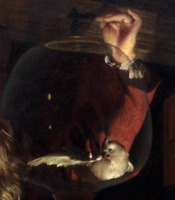
Flight
A chorus of juvenile heartbeats affected by Atrial Septal (ASD) and Ventricular Septal Defects (VSD), Patent Ductus Arteriosus(PDA), and Aortic Valve Stenosis (AVS), transposed to a higher frequency to simulate birdsong -

Holes
A virus attacks a cell by attaching itself to the outer wall. It then uses a specialized protein to digest a small hole in the wall of the cell and inject its nucleic acid molecule into the cell's cytoplasm. -
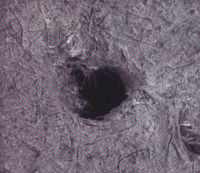
Brontëan Abstract
Pinhole made by Charlotte Brontë -
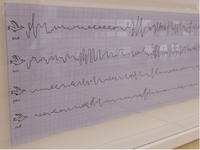
Flight
A chorus of juvenile heartbeats affected by Atrial Septal (ASD) and Ventricular Septal Defects (VSD), Patent Ductus Arteriosus(PDA), and Aortic Valve Stenosis (AVS), transposed to a higher frequency to simulate birdsong -
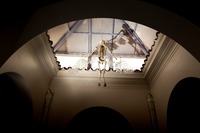
Icarus
Perspex wings with histology slides. Histology slides are prepared by taking a sample of biological tissue and fixing it to preserve the tissue in as natural a state as possible and prevent postmortem decay. The tissue is immersed in a chemical fixative and then embedded in wax to make it hard enough to cut into very thin sections of tissue (usually 5 to 7 micrometers in thickness). It is then passed through baths of solvents which remove the wax, then through graded alcohols, water and finally through baths of haematoxylin and eosin to stain it for better viewing under a microscope. -
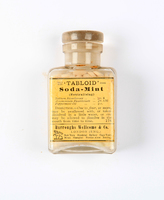
Soda-Mint (Neutralising)
"Antacid, exhilarant and stimulant. From one to three as a neutralising agent, in irritable and acid conditions of the stomach, dyspepsia, flatulence, etc. They may be swallowed with water, or be powdered and dissolved in water and taken as a draught" (BWC 1925:138).


